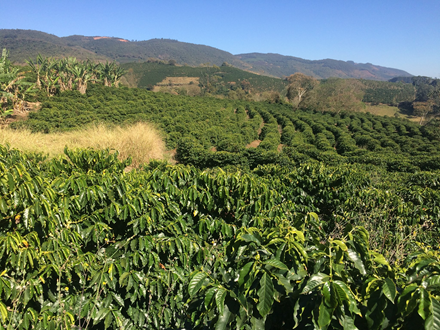In a new study, González-Chaves and colleagues assessed pollination benefits at a national scale by identifying where pollination services are more likely to be provided by native bees as a result of forest conservation.
Coffee is a highly traded crop, which is produced in the tropics and enjoyed across the globe. Like most crops, coffee benefits from pollination services. However, this is rarely considered by agronomists and producers because the technical knowledge needed to effectively monitor pollinators is often lacking.
Our study took place in the Atlantic Forest biome, a region responsible for 20% of global coffee production. By combining satellite information from the Mapbiomas.org with governmental agricultural census information, we were able to demonstrate a positive relationship between crop productivity (kg/hectares) and forest conservation in the surrounding areas of coffee fields, regardless of variations in climatic conditions, soil conditions and agricultural management scenarios.

Of the 1.3 million hectares analysed across the Atlantic Forest Biome, more than half of the of coffee plantations were in regions with over 20% forest cover. Above this threshold, the biological communities tend to be more diverse, and forest fragments promote pollinators and natural pest enemies that increase crop productivity. Moreover the coffee fields in these areas are, on average, less than 200 meters from forest fragments, meaning the bees and pest enemies within the fragments can easily reach the coffee fields.
It should be noted – the contribution of forest conservation to coffee production is not expected to be equal for the two coffee species in these plantations. Our study shows that Coffea canephora benefits more from forest conservation, as this species is fully dependent on bees for pollinating coffee flowers. For C. arabica, the productivity stabilises at around 20% of forest cover. However, this is still double that of regions with less than 5 % of forest cover.
Our work enables us to identify which areas would benefit the most from forest restoration. This is possible because we considered the forest cover that surrounds coffee fields within a 2 km buffer for each of the 30×30 m2 of coffee pixel, thus allowing us to prioritise coffee fields which are more distant from forest fragments.
Finally, we were also able to demonstrate that forest cover and the pollinator demand index were more relevant factors than the climatic conditions, agricultural practices, soil properties and altitude variables considered.

The restoration of regions with less than 20% of forest cover could increase coffee production by an estimated 86 million dollars. It could also help to contribute 2% to the restoration goal for the Atlantic Forest Biome. This information is critical to guide coffee production and restoration efforts.
Perhaps more importantly, our work provides accessible information for coffee consumers to assess the conservation status of the region where their coffee is produced. This guidance is crucial to improve the sustainability of current and future coffee production (as certification efforts inform about on farm practices) and evidence shows that biodiversity conservation relies on landscape conservation efforts.
Read the full article Positive forest cover effects on coffee yields are consistent across regions in Journal of Applied Ecology.

One thought on “Knowing where your coffee comes from has the potential to aid restoration efforts ”